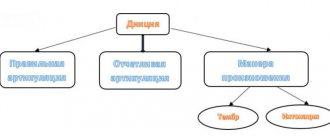Weekly program of classes to improve diction
I know firsthand how difficult it is to apply other people’s advice in life, even if it’s at least three times brilliant and super useful. Within an hour after reading the article, only 40% of the information received will remain in your head. This means that 6 out of 10 tips and exercises will be unclaimed.
To avoid this, I created a mini-program for working on diction. Copy it somewhere or save the article to your bookmarks so you can do the exercises every day.
Monday:
- Talk for 15 minutes with a clenched pencil in your teeth, walnuts or a cork in your mouth;
- read aloud an excerpt from a book of about 1 page;
- perfect the pronunciation of one tongue twister;
- practice the sounds K and G.
Tuesday:
- Talk for 15 minutes with a clenched pencil in your teeth, walnuts or a cork in your mouth;
- recite any poem you know by heart;
- voice an excerpt from your favorite cartoon;
- practice the sounds Ж and Ш.
Wednesday:
- Talk for 15 minutes with a clenched pencil in your teeth, walnuts or a cork in your mouth;
- record any passage on a dictaphone, listen to the recording and note all speech defects;
- correct them and record the passage again;
- practice the sound C.
Thursday:
- Talk for 15 minutes with a clenched pencil in your teeth, walnuts or a cork in your mouth;
- read any passage out loud as slowly as you can;
- practice pronouncing difficult words;
- practice the sounds B and P.
Friday:
- Talk for 15 minutes with a clenched pencil in your teeth, walnuts or a cork in your mouth;
- learn by heart several complex tongue twisters;
- practice the sounds Z and S.
Saturday:
- Talk for 15 minutes with a clenched pencil in your teeth, walnuts or a cork in your mouth;
- practice pronunciation of prepositions ending in a consonant.
Sunday:
- Talk for 15 minutes with a clenched pencil in your teeth, walnuts or a cork in your mouth;
- read 2 pages of any text, clearly pronouncing the endings.
Exercise 4. “Sherlock”
Place the words on a piece of paper. Very different, not very long. In no particular order. Kind of scatter them across the paper. Name one of the words and ask the child to find it. Words could be, for example:
frame, jelly, spoon, chair, horse, gold, soap, pen, mouse, mouth, knee, dog, summer, lake, cancer
Each next word will be found faster than the previous one. Since, while trying to find one word, the student will read others along the way and remember where they are. And that's all we need.
Thanks to Sherlock, the viewing angle increases. And reading speed.
Exercise 9. “Oh, once! Again!"
For this exercise we will need a stopwatch and a text to read.
Read for 1 minute. We pay attention to reading speed, but you can forget about expressiveness for now. Ready? Go!
The minute is up. Stop! Let's make a mark where we left off.
Let's rest a little and read the same text again. Go! In a minute we make a notch. Wow! Already more.
What will happen the third time? And the third time will be even better!
What does this give us? Increase reading speed. And the child's motivation. He will see for himself that he is capable of more.
What are tongue twisters?
Vladimir Ivanovich Dal described tongue twisters as follows:
A tongue twister, a pure tongue twister, is composed to exercise rapid and clear pronunciation, why sounds collide in it, making it difficult to speak quickly; but many pure stories also include the proverb: “You can’t change our sexton” (you can’t change a person); “I reported, but didn’t complete the report, but began to complete the report, then reported” (all at random, unsuccessfully); “There is a priest on a head, a cap on the priest, a head under the priest, a priest under a cap” (that is, everything is the same).
Method 2: ioBit
The ioBit online service is suitable only in cases where you need to check how the microphone responds to voice, but without listening to it.
Go to the ioBit online service
- On the ioBit home page, click on the microphone icon.
- Allow access to your device so the site can capture audio.
- If the bar does not move, it means that the voice is not being recorded on the microphone.
- As soon as you see fluctuations when speaking at different volumes or simply hitting the microphone with your finger, it means the recording is going great.
Method 1: OnlineVoiceRecorder
The first online service is called OnlineVoiceRecorder, and from the name it is already clear that its functionality is focused on voice verification.
Go to the OnlineVoiceRecorder online service
- Open the OnlineVoiceRecorder online service, where you can immediately click on the red button with a microphone to start recording.
- If a pop-up notification appears on your screen, select "Allow" there.
- Recording will begin, and volume fluctuations will be monitored by a special line that changes the state in real time. OnlineVoiceRecorder has only two control tools: the first stops recording completely, and the second pauses it.
- Now you can trim the recording or listen to it to check the voice quality.
- If necessary, download this track or close the form and start recording a new one.










